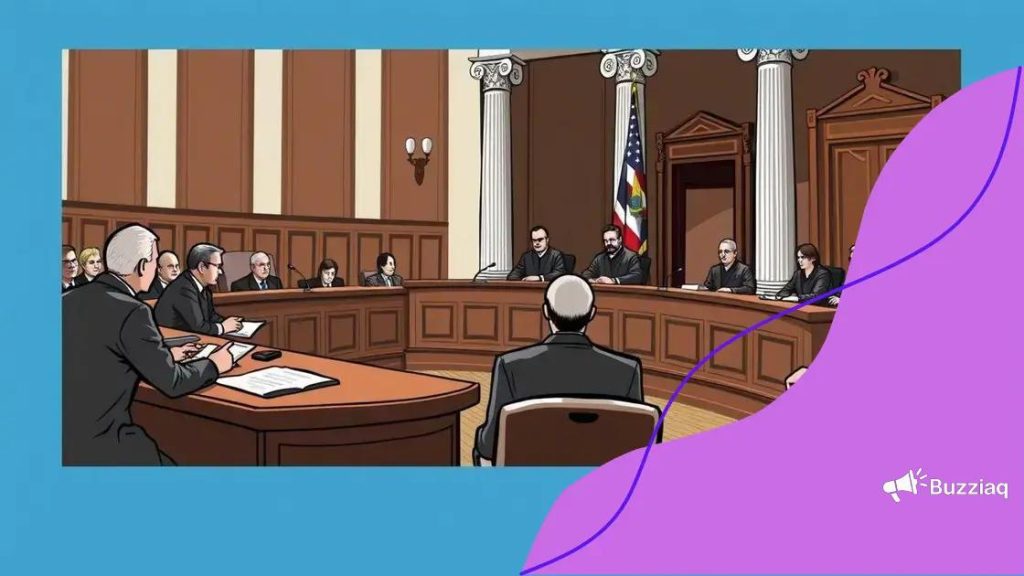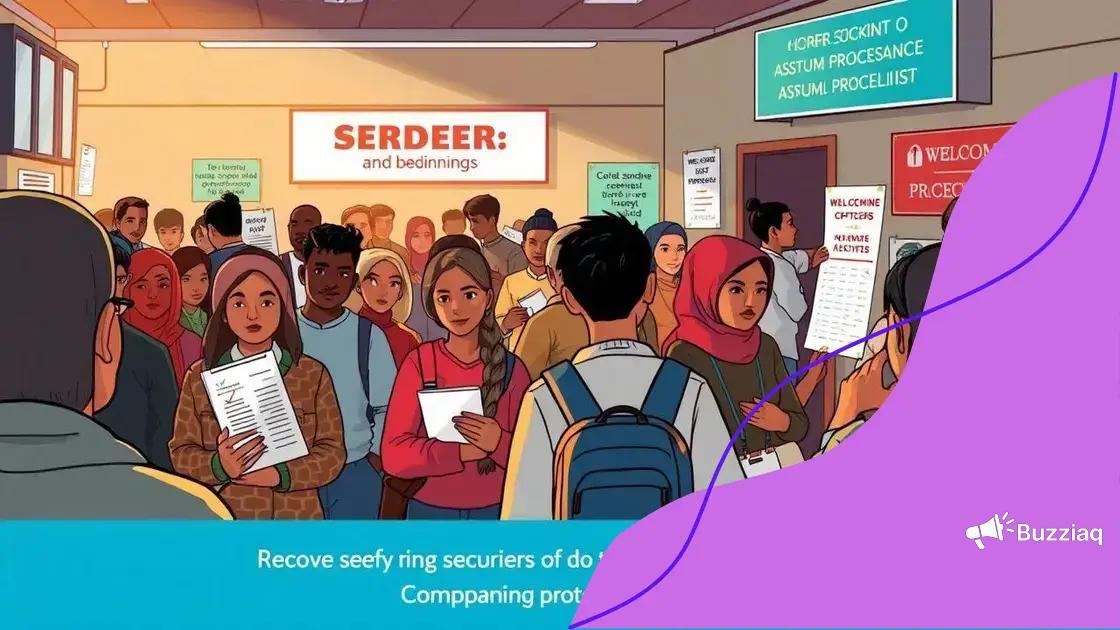Supreme Court decisions on immigration policies that matter

AD
Supreme Court decisions on immigration policies critically shape the legal framework governing asylum, refugee status, and the rights of immigrants, influencing both laws and public perception in the United States.
Supreme Court decisions on immigration policies are reshaping the landscape of U.S. immigration law. Have you ever wondered how these rulings impact the lives of millions? Let’s dive into the pivotal cases and their real-world effects.
AD
Historical context of immigration policies
The historical context of immigration policies in the United States is essential to understanding current laws and regulations. Many factors contributed to shaping these policies over the years, including economics, culture, and significant events in U.S. history.
In the late 19th and early 20th centuries, industrialization created a demand for labor, attracting millions of immigrants. This period welcomed many from Europe, particularly from countries like Italy and Ireland. However, as the wave of new arrivals increased, so did concerns about their integration into American society.
Key Legislation Impacting Immigration
Several laws have marked crucial turning points in U.S. immigration policy:
AD
- Immigration Act of 1924: Limited immigration from certain countries based on quotas.
- McCarran-Walter Act of 1952: Established a system for immigration based on skills and family connections.
- Immigration and Nationality Act of 1965: Eliminated national origins quotas, allowing for a greater diversity of immigrants.
- Deferred Action for Childhood Arrivals (DACA): Introduced in 2012 to protect eligible immigrant youth from deportation.
Throughout history, public opinion has swayed between viewing immigration as a threat and recognizing its contributions to society. The Great Depression in the 1930s led to stricter laws aimed at controlling immigration, while the post-World War II era saw a shift, emphasizing the need for labor in reconstruction efforts.
As global conflicts arise, U.S. immigration policies adapt to current situations. Crises such as the Vietnam War and the Syrian Civil War have prompted adjustments in how refugees are treated. Today, immigration remains a contentious issue, with policies often reflecting the prevailing political climate.
Key Supreme Court cases affecting immigration
Understanding the key Supreme Court cases affecting immigration is vital for grasping how immigration laws evolve. These rulings have significant implications for individuals and families navigating the system.
One landmark case is INS v. Chadha (1983). This case addressed the power of Congress regarding immigration and deportation procedures. The Supreme Court ruled that the one-house veto, which allowed Congress to overrule certain immigration decisions, was unconstitutional. This ruling reinforced the importance of checks and balances within immigration law.
Major Supreme Court Cases
Other important cases include:
- United States v. Texas (2016): This case involved a challenge to the Deferred Action for Parents of Americans (DAPA) program, highlighting the limits of executive power in immigration enforcement.
- Sessions v. Dimaya (2018): This case examined the definition of a violent crime under immigration law. The ruling found the definition to be unconstitutionally vague, affecting many immigrants facing deportation.
- Perez v. McAleenan (2019): In this case, the court addressed the rights of asylum seekers, emphasizing the legal protections available to those fleeing persecution.
Each case has provided clarity on complex issues surrounding immigration and has influenced legislative changes. For instance, the decision on DAPA led to discussions about the balance between immigration reform and executive authority.
As these cases illustrate, the Supreme Court plays a crucial role in interpreting immigration laws, often shaping the lives of countless individuals. The rulings can affect family reunification, deportation proceedings, and the rights of non-citizens living in the U.S.
Impact of recent decisions on asylum seekers

The impact of recent decisions on asylum seekers has been significant, as policies shift to address ongoing global crises. These decisions often determine the fate of many individuals seeking safety and refuge in the United States.
One notable case is the Trump administration’s Migrant Protection Protocols, also known as “Remain in Mexico.” This policy forced asylum seekers to wait in Mexico while their claims were processed in the U.S. This led to challenging conditions for many, raising concerns about their safety.
Current Policies Affecting Asylum Seekers
Important aspects include:
- Changes in Criteria: Recent rulings have refined the criteria under which individuals can claim asylum, focusing on fear of persecution based on race, religion, and political opinion.
- Legal Representation: The right to legal representation has become a pivotal issue, impacting the success rates of asylum applications.
- Expedited Processing: New measures for expedited processing have been implemented, which aim to meet the needs of those in immediate danger but can also lead to rushed evaluations.
These changes highlight the ongoing struggles faced by asylum seekers. The journey for many remains fraught with uncertainty and obstacles. Additionally, families often find themselves torn apart due to lengthy processing times.
With ongoing litigation regarding policies, the situation remains fluid. Advocacy groups continue to challenge decisions that they believe undermine the rights of asylum seekers, pushing for reforms that ensure fair treatment and access to asylum.
Future implications for immigration law
The future implications for immigration law are complex and often depend on shifting political landscapes and public sentiment. As global issues like climate change, economic disparities, and international conflicts continue to rise, they will likely influence new legislative measures.
Ongoing debates about immigration reform highlight several potential changes. Areas of focus include:
Prospective Legislative Changes
- Pathways to Citizenship: There is increasing discussion around creating pathways for undocumented immigrants to gain legal status, particularly for those who have been contributing to society for years.
- Refugee and Asylum Policies: As crises emerge, policies regarding asylum seekers are likely to evolve, aiming to balance humanitarian needs with security concerns.
- Technology in Immigration Processing: Advancements in technology may streamline application processes and improve tracking, making it easier for authorities to manage immigration flows.
Moreover, the effects of recent Supreme Court rulings may shape future actions. Cases that have clarified the rights of immigrants will likely guide lawmakers in crafting more precise and effective laws.
As society’s views on immigration shift, this will impact everything from local community responses to federal policies. Activism and public opinion will continue to play vital roles in shaping the narrative around immigration and the laws governing it.
Debates surrounding Supreme Court rulings
The debates surrounding Supreme Court rulings on immigration are often intense and multifaceted. These discussions reflect broader societal values and concerns, influencing public opinion and policy.
One key area of debate is the balance between security and humanitarian needs. Rulings that tighten immigration laws can often spark backlash from advocates who argue these decisions undermine the country’s commitment to asylum seekers.
Major Points of Contention
Key topics include:
- Executive Power vs. Legislative Authority: Critics argue that the Supreme Court sometimes expands executive power in ways that limit the legislative branch’s role in shaping immigration policy.
- Due Process Rights: Debates often focus on whether recent rulings adequately protect the due process rights of non-citizens, especially in deportation cases.
- The Role of Precedent: Each ruling adds to a growing body of case law, and debates arise around how faithfully future courts will adhere to these precedents in immigration cases.
Furthermore, these debates often extend to how ruling outcomes affect immigrant communities. Public perception of immigrants can shift dramatically based on these high-profile cases, impacting everything from local policies to national elections.
As society evolves, the conversations around these rulings will continue to shape America’s immigration landscape, reflecting changing attitudes and political climate.
FAQ – Frequently Asked Questions about Supreme Court Decisions on Immigration Policies
What role does the Supreme Court play in immigration law?
The Supreme Court interprets immigration laws and its rulings can significantly impact how these laws are enforced and applied.
How do recent rulings affect asylum seekers?
Recent rulings have tightened protocols for asylum seekers, impacting their ability to gain refuge and navigate the legal system.
What are the key debates surrounding immigration policies?
Key debates focus on balancing security with humanitarian needs, the implications of executive power, and the protection of immigrant rights.
What are the potential future changes for immigration law?
Future changes may include pathways for citizenship and adjustments to asylum policies, responding to global humanitarian needs and political climates.